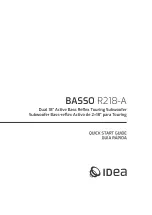
Step 6: Fine Tuning
Now that the basic setup is complete, it’s time for optimization. Mark down the current volume and crossover settings with a soft pencil
so you can go back to where you started.
Variable Tuning
If you don’t like the air shaking feeling of very deep bass, or if you often listen to extremely loud chest-thumping material that has less
deep bass, Maximum Output mode is for you.
You can switch over to Maximum Output mode when the system’s volume level is low or the subwoofer is OFF. There are two steps:
1) Grip and pull out the foam port plug that is inserted in one of the port holes on the back of the subwoofer.
2) Flip the BASS EXTENTION switch on the back of the subwoofer to the MAX OUTPUT mode.
In technical language, you will get about 4 dB of extra head-room so that bass can be played louder, at the expense of some deep bass exten-
sion. In other words, the subwoofer has been transformed into a louder device with less deep bass.
Switching back is simply a matter of firmly re-inserting the port plug into one of the port holes, and flipping the switch back to MAX
EXTENSION mode. Make sure that the switch setting is consistent with the port setting. Using the wrong switch position at loud vol-
ume levels may damage your subwoofer and void the warranty.
Setting the Phase
Depending on the absolute phase of your main speakers and amplifier, and the distances of the subwoofer and the main speakers from
the listening position, the bass in the crossover region may be smoother if you reverse the phase of the subwoofer. Switch the phase switch
to 180 degrees to see if the bass sounds louder in the seating position. Play program materials with steady, consistent bass in the crossover
region (30 – 90 Hz). Filtered pink noise is best, but you may use music containing bass drums, double basses, bass guitar, etc.. The more
bass-heavy setting is where the output of the subwoofer and the main speakers are most in phase. If the 180 degree position is louder, you
will need to go back and adjust the volume level (Step 4). Otherwise, just switch the phase switch back to the original position.
Turning the subwoofer ON for the first time
On the subwoofer, check that the phase switch is at 0 degrees, the volume level knob is at the minimum, and the crossover is at 90 Hz if using
the subwoofer’s crossover. Run the power cord from the wall to the subwoofer and flip the power switch to the AUTO-ON or ON position.
Optional: subwoofer integration will be more accurate when using test tones and a SPL meter. See Step 6 (Fine Tuning).
Step 5: Crossover
If you are using the SUBWOOFER or LFE output on your controller, you may optionally set the CROSSOVER switch to OUT. This lets
the controller handle the crossover between the subwoofer and other speakers. However, if the bass sounds boomy, it may sound better
with the crossover switched IN and the CROSSOVER FREQUENCY set to 90 Hz. You may skip the rest of this step.
If you are using the HIGH LEVEL speaker connections, you will be using the subwoofer’s crossover. Look up the lowest frequency your
left and right speakers will output (the frequency they are“-3 dB” at) and set the crossover approximately to this point. Play program mate-
rials with steady, consistent bass around this frequency such as filtered pink noise or music containing bass drums, double basses, bass
guitar, etc. Turn the crossover to the left until you hear the subwoofer and L/R speakers as separate sources. Slowly turn the control back
to the right until the sound of all three speakers is well integrated. When using tiny front speakers that don’t have much bass, the 90 Hz
setting on the control will probably yield the best results.
Your subwoofer has a sharp 24 dB/octave crossover to remove the midbass and midrange in the subwoofer. This makes your subwoofer
non-directional. Unlike many other subwoofers on the market, the 24 dB/octave slope stays steep at all available frequencies, not just
the high ones.
5
Step 4: Volume Level
Many people use ordinary music recordings or soundtracks for setting the subwoofer’s volume level.
If you are using this method, try adjusting the subwoofer’s volume level so it matches the main speakers at
the listening position. Since most people do not listen to material at very loud reference levels and the ears
are less sensitive to bass at lower levels, some listeners prefer to set the bass level a little higher than the main
speakers. A good approach is to set the subwoofer level to the highest level where it sounds nice and where
bass and kick drums still sound tight and non-boomy. For home theater applications, most prefer to set the
subwoofer level higher than the other speakers. We suggest setting it about 3 dB higher. Some proces-
sors/receivers allow you to set different bass levels for different sources.
Содержание VTF-2
Страница 10: ...10 Notes ...
Страница 11: ...11 Notes ...
Страница 12: ...12 HSU Research 3160 E La Palma Avenue D Anaheim CA 92806 800 554 0150 HSURESEARCH COM ...






























